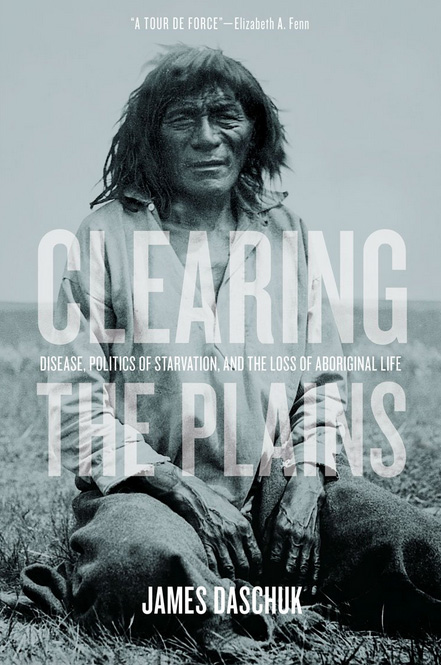Book Review: Sir John A. aided mass starvation
 Reviewed by Karl Hele
Reviewed by Karl Hele
James Daschuk’s study of disease and policy on the plains from the 1700s to the late 1800s is a depressingly informative read. Daschuk details the effects of diseases such as small pox, influenza, measles, and tuberculosis on the Plains Indian populations’ health and well being, while examining how Canadian policy increased suffering and mortality as well as how this continues to affect contemporary communities.
The first section of Daschuk’s book traces early epidemics across the plains prior to the 1870 assumption of control by Canada. Here he illustrates connections between environment, trade, disease, and population shifts. For instance, early exposure to European diseases in the 1600s allowed the Anishinaabeg to expand west as formerly more numerous populations, such as the Assiniboine, experienced precipitous population declines. Overall the first section shows how Indian health declined across the plains in the pre-control period through a complex process of environmental change and degradation as well as increasing linkages with global trade and microbes.
The second section of the book is the most horrifying to read. While it is generally understood that government policies negatively affected First Nations health, Daschuk deftly shows how Canada, led by Sir John A. Macdonald, aided and abetted mass starvation and ill health. Treaty 6, which included a provision for support in times of famine, obligated Canada to support Plains Peoples. Yet parsimony, corruption, and domination combined with the ‘National Dream’ to clear the plains of Indians. Budget cuts and the idea of ‘working for rations’ drove many Cree and other First Nations people to starvation. Macdonald even acknowledged that cuts would create “genuine suffering” (164). While Lieutenant-Governor Edgar Dewdney, argued for increased ration, he aided and abetted an American supply firm in its efforts to secure government contracts to feed starving Indians. This naturally led to questionable quality and type of food being delivered to communities. Indian Agents and Farm Instructors, some caring and some callus, were left to implement increasingly cheap and harsh policies. This led to increased exploitation by Indian Department employees and other settlers. Even more galling was the manipulation of rations by Macdonald to ensure that the Indians complied with treaties, followed Indian policy, and remained on their reserves.
The Plains Indians’ susceptibility to disease increased as famine and starvation took hold. Rations of beef and unpasteurized milk infected weakened people with Tuberculosis (TB). Disease outbreaks became increasingly virulent and more common as trains brought more settlers west. By blaming the sick and starving, settlers gradually convinced themselves that Indians had a hereditary disposition to various diseases, particularly TB, and that the reserves were simply cesspools of infection, for which little could be done. This opinion, according to Daschuk, became entrenched by the 1890s. He also notes that the decline in TB among reserve populations only occurred with the widespread use of antibiotics after World War II. This statement returns to the main point of the book, that the modern health issues facing Aboriginal communities remain directly tied to government policies of the past and their continuation into the present.
I highly recommend that everyone read this book. It is well written and exposes a very dark side in Canada’s colonial past and present. The reader, however, must be aware that the book is quite ‘heavy’ in terms of its account of human suffering.
Daschuk, James. Clearing the Plains: Disease, Politics of Starvation, and the Loss of Aboriginal Life. Regina: University of Regina Press, 2013.


